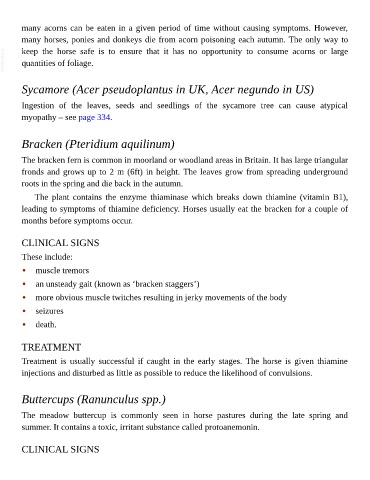Page 809 - The Veterinary Care of the Horse
P. 809
many acorns can be eaten in a given period of time without causing symptoms. However,
many horses, ponies and donkeys die from acorn poisoning each autumn. The only way to
VetBooks.ir keep the horse safe is to ensure that it has no opportunity to consume acorns or large
quantities of foliage.
Sycamore (Acer pseudoplantus in UK, Acer negundo in US)
Ingestion of the leaves, seeds and seedlings of the sycamore tree can cause atypical
myopathy – see page 334.
Bracken (Pteridium aquilinum)
The bracken fern is common in moorland or woodland areas in Britain. It has large triangular
fronds and grows up to 2 m (6ft) in height. The leaves grow from spreading underground
roots in the spring and die back in the autumn.
The plant contains the enzyme thiaminase which breaks down thiamine (vitamin B1),
leading to symptoms of thiamine deficiency. Horses usually eat the bracken for a couple of
months before symptoms occur.
CLINICAL SIGNS
These include:
• muscle tremors
• an unsteady gait (known as ‘bracken staggers’)
• more obvious muscle twitches resulting in jerky movements of the body
• seizures
• death.
TREATMENT
Treatment is usually successful if caught in the early stages. The horse is given thiamine
injections and disturbed as little as possible to reduce the likelihood of convulsions.
Buttercups (Ranunculus spp.)
The meadow buttercup is commonly seen in horse pastures during the late spring and
summer. It contains a toxic, irritant substance called protoanemonin.
CLINICAL SIGNS

